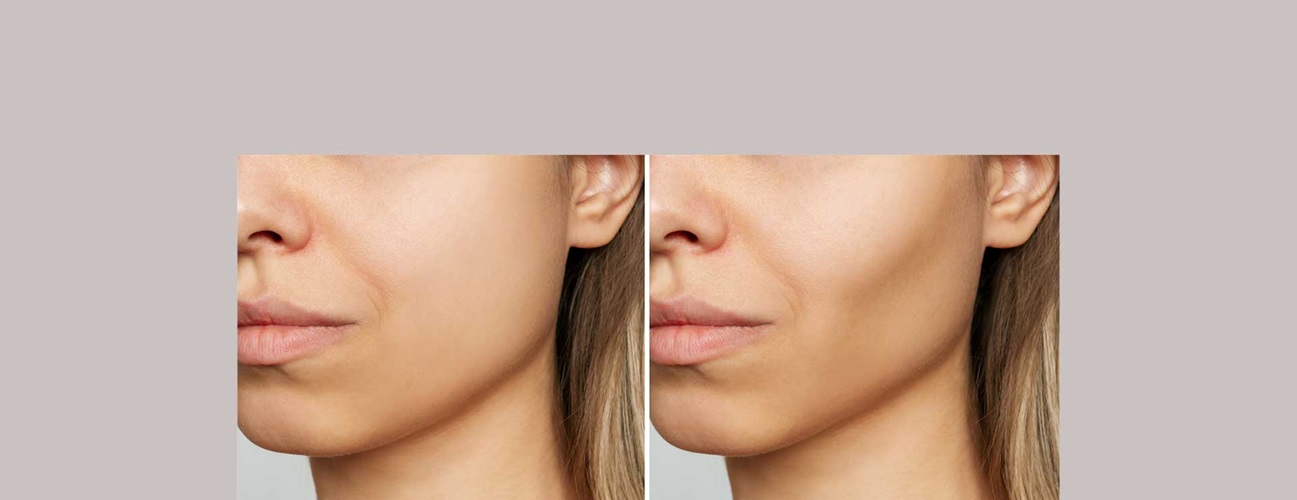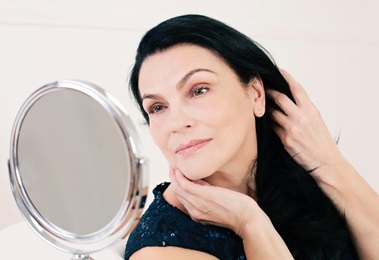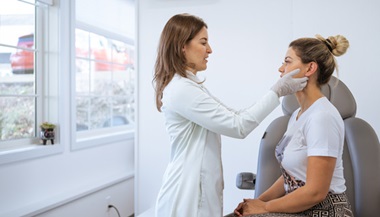Buccal Fat Removal
Featured Expert
Buccal fat removal, also called buccal lipectomy or cheek fat removal, can create a slimmer face by surgically removing fat pads in the lower cheek. Kofi Boahene, M.D., director of facial plastic and reconstructive surgery at Johns Hopkins Medicine, explains the procedure, its effects, recovery time and more.
What You Need to Know
- Buccal fat removal reshapes the face by removing all or some of the buccal fat pad in the lower cheek.
- The removed fat cells do not grow back.
- The incision (cut) is made in the mouth, on the inside of the cheek, and leaves no scars on the face.
- This is a cosmetic and elective procedure that is not covered by insurance.
What is buccal fat removal?
Buccal fat removal is an elective plastic surgery procedure to remove fat in the lower cheek, which gives the bottom part of the face a narrower shape and emphasizes the cheekbones and jawline.
Buccal fat is a pad of adipose tissue (fat) in the cheek below each cheekbone. The size and shape of these pads varies from person to person. More fat in the buccal region can give the face a round appearance.
Removing buccal fat can make the cheekbones more defined and by creating a shadow contrast between the cheekbones and the lower jaw while making the face look less round and more V-shaped. Some or all buccal fat may be removed during the procedure, depending on the desired facial shape. Buccal fat pads do not grow back, so the results are long-lasting. However, there are other fat cells in the face that may expand if there is significant weight gain.
Buccal fat removal may be performed along with other facial cosmetic surgery procedures.

How is buccal fat removal different from cheek liposuction?
In cheek liposuction, fat is vacuumed out of the face using a narrow tube and a suction device. Buccal fat removal involves surgery to remove the pad of fat beneath the cheekbone. Your plastic surgeon can recommend the best method to address cheek fullness and contour the face.
Does buccal fat removal help with smile lines?
Large buccal fat pads could emphasize the smile lines — the lines that extend from the sides of the nose to the corners of the lips. Although removing the buccal fat may reduce the appearance of deep smile lines in some people, this is not the goal of the procedure. Tightening the skin with a face-lift is a more long-lasting solution to deep smile lines.
Who is a candidate for buccal fat removal?
Buccal fat removal is a personal choice, which makes it an elective procedure. Anyone who desires more prominent cheekbones or a less rounded face may opt for buccal fat removal. Nuances due to individual health and face structure may cause the results to vary from person to person. Consulting with a facial plastic surgeon can help you make an informed decision on whether benefits of the procedure outweigh the risks in your case.
For people who already have a narrow face, buccal fat removal may accentuate the narrow appearance and result in an overly gaunt look. On the other hand, the procedure’s effects may be less noticeable for someone who is overweight or obese. Because weight changes can affect the volume of fat in the cheeks, having achieved a desired weight before the procedure helps better envision the outcome of buccal fat removal and may help avoid an overly hollow look if there is substantial weight loss in the future.
Is there an age guideline for buccal fat removal?
Most doctors recommend people wait until ages 18-20 before removing buccal fat because the face shape and buccal fat pads change as the face matures. Some people with a rounded face in their youth grow out of it.
On the other hand, older adults may lack skin elasticity and may experience sagging in the lower face if buccal fat is removed without other procedures such as a face-lift.
Preparing for Buccal Fat Removal
It is very important that you tell your surgeon about all your health conditions and all medications and supplements you take. The care team will likely ask you about these at the consultation and review with you again the day of surgery.
If you smoke, do your best to stop, as smoking can cause facial surgery complications and poor cosmetic results.
Your doctor will also discuss the anesthesia options with you. Buccal fat removal can be performed under general anesthesia (with the patient asleep) or local anesthesia (when only the face is numbed). When performed without other concurrent procedures, buccal fat removal is often done in a doctor’s office under local anesthesia.
If you are having general anesthesia, you may be instructed not to eat or drink anything the night before and the day of your surgery. For local numbing anesthesia, this is usually not necessary.
Be sure to arrange for someone to drive you home after your surgery if it is performed under general anesthesia.
What Happens During Buccal Fat Removal
Once you have consulted with your surgeon, agreed on goals, and discussed financing and all other concerns, your procedure will be scheduled.
The buccal fat removal procedure takes about 45 minutes. During the procedure:
- You will be given either general anesthesia (medicine given intravenously so you are asleep during the procedure) or local anesthesia (numbing medication injected into the inside of the cheek with a needle).
- When you are asleep or completely numb, the surgeon makes a small incision (cut) inside the cheek.
- The soft buccal fat pad, visible to the surgeon, is grasped by forceps (a tweezer-like instrument) and moved through the incision. The surgeon then removes the desired amount of buccal fat pad to achieve the desired result.
- The incision is closed with dissolvable sutures (stitches).
- The process is repeated on the other cheek.
Recovery After Buccal Fat Removal
Recovery after buccal fat removal takes about three weeks, but it may take longer to see the results as your face shape adjusts around the missing fat pads. The swelling in your face will start to go down after a week and will gradually fade away, revealing your results after about two months.
During the recovery process:
- Bruising and swelling are normal after buccal fat removal.
- Plan to take 5 to 7 days away from work and normal activities.
- During the first day or two, eating softer foods may feel more comfortable.
- The healing incisions inside of your mouth may be sore for a while, and the numbness around the incision may persist for several weeks.
- Pain at the incision sites is normal and can be managed with over-the-counter pain relievers and ice packs applied to the outside of the jaw.
Buccal Fat Removal Risks and Side Effects
Cheek reduction surgery is generally safe. Rarely, the following can occur:
- Excessive bleeding
- Problems associated with general anesthesia
- Infection at the incision site
- Injury to facial nerves that can cause numbness or facial drooping
- Injury to salivary glands or ducts
- A prematurely gaunt or aged appearance of the face (if too much fat is removed)
- Asymmetry of the face (one side of the face does not look like the other)
Some of these risks can be minimized by working with an experienced surgeon. For example, because every person’s face is slightly different on both sides, an experienced surgeon can take your unique face shape into account when planning your procedure to minimize asymmetry. However, it is not likely that both sides of your face will be perfectly identical before or after a cosmetic facial procedure.
For this or any cosmetic plastic surgery, the skill and expertise of the surgeon is essential to ensuring a safe procedure, optimal healing and pleasing results.
When to Call a Doctor
Call 911 or go to the emergency room if you experience any shortness of breath, chest pain or unusual heartbeat after buccal fat removal.
Call your doctor if you experience:
- Fever
- Redness or pus
- Bleeding
- Unpleasant taste in the mouth
Will buccal fat removal effects last as you age?
What will I look like 10 years after buccal fat removal? This is a good question to consider before opting for this procedure. The buccal fat pads are removed permanently; they do not grow back. Your new face shape should last, unless you experience substantial weight gain or loss.
Aging after buccal fat reduction can intensify the slimming effects. As people age, they lose fat and muscle volume in the face naturally. In addition, the skin can become lax and begin to sag.
This normal process may explain why some people who have cheek reduction surgery have noticed that years later their faces appear older than they would expect. To an extent, having some buccal fat in the cheek can preserve a smoother, more youthful appearance as a person ages.
Buccal Fat Removal Cost
The cost for buccal fat removal can range widely depending on your location, the expertise of the surgeon and costs related to surgery and the type of facility.
Having the cheeks reshaped with buccal fat reduction is a cosmetic procedure ― it addresses the appearance, not the physical health. For that reason, medical insurance does not cover buccal fat removal. Consult with your doctor to ensure you are aware of all charges associated with the procedure such as imaging, anesthesia, tests and prescriptions.







